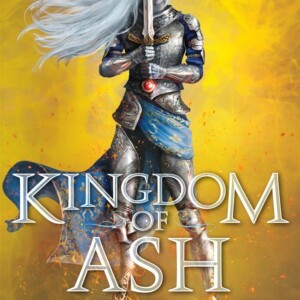Episodes

4 days ago
4 days ago
1 What's Crier's War
"Crier's War" by Nina Varela is a fantasy novel set in a world where humans and automae, sentient beings created to serve them, grapple with issues of power, identity, and love. The story primarily follows two protagonists: Crier, an heiress automa who struggles with her programmed loyalties and the expectations of her society, and Ayla, a human girl driven by a desire for revenge against the automae for past injustices. As their paths intertwine, the novel explores themes of rebellion, the complexity of human emotions versus artificial constructs, and the fight for autonomy and acceptance in a world marked by prejudice and inequality, ultimately culminating in a poignant examination of love that challenges societal boundaries.
2 Key Concepts of Crier's War
In "Crier's War" by Nina Varela, the theme of power dynamics and the struggle for agency is prevalent throughout the novel. In addition to Chapter 1, this theme is particularly evident in Chapter 2, where the inequities between humans and the Automae are starkly illustrated, highlighting how societal structures dictate the characters' lives. Chapter 4 further explores the internal conflicts of the protagonists as they navigate their desires for autonomy amid oppressive systems. Chapter 7 deepens this theme by showcasing pivotal moments that challenge traditional roles and provoke questions about identity and rebellion, ultimately underscoring the characters' quest for power and self-determination.
3 In-Depth Chapter Analysis of Crier's War by Nina Varela
In "Crier's War" by Nina Varela, the early chapters lay the groundwork for the intricate relationship between the themes of power, identity, and forbidden love. In Chapter 1, we are introduced to Aylen, a human who lives under the oppressive rule of the Automa, a race of robotic beings. This chapter illustrates the power dynamics at play, showcasing the animosity and resentment held by humans towards their Automa rulers. For instance, Aylen’s disdain for the Automa is palpable, emphasizing the theme of oppression and the struggle for freedom. This contrasts sharply with Crier, the Automa princess, who grapples with her own identity and emotions, particularly in Chapter 5, where her curiosity about humans and her emerging feelings for Aylen signify a burgeoning awareness that challenges her programmed beliefs.
As the story unfolds, the connection between Aylen and Crier deepens, particularly in Chapter 7, where they share a pivotal moment that explores both vulnerability and desire. Here, the author brilliantly weaves themes of love and rebellion as they confront societal expectations and their own identities. Their interactions highlight the tension between duty and desire, showcasing the lengths to which they are willing to go to defy their worlds. This intertwining of personal and political struggles illustrates a profound commentary on the nature of power and love, ultimately driving home the message that the fight for agency often transcends the boundaries set by oppressive regimes.
Book Summary Audio Bookey https://www.bookey.app/audiobook/crier's-war
Quotes https://www.bookey.app/book/crier%27s-war/quote
Youtube https://www.youtube.com/watch?v=EyIMwb90lBU
Amazon https://www.amazon.com/Criers-War-Nina-Varela/dp/0062823949
Goodreads https://www.goodreads.com/book/show/41951626-crier-s-war

5 days ago
5 days ago
1 What's The Love That Split the World
"The Love That Split the World" by Emily Henry explores the themes of love, identity, and the complexities of navigating relationships across different realities. The story follows Natalie, a high school senior who experiences time slips that transport her to alternate versions of her life, where she grapples with her feelings for her best friend, Beau. As she faces the pressures of impending adulthood and the challenges of her family's expectations, Natalie must decipher the nature of her reality and the significance of her connections. The novel delves into the magical realism of love and fate, ultimately emphasizing the importance of self-discovery and the choices that define our paths.
2 Key Concepts of The Love That Split the World
In "The Love That Split the World" by Emily Henry, Chapter 1 introduces the theme of love intertwined with the complexities of time and reality. This theme reverberates throughout several subsequent chapters, particularly in Chapters 7 and 15. In Chapter 7, Natalie grapples with her feelings for them, exploring the nature of her connection with him and how it transcends time and space. Meanwhile, Chapter 15 deepens this exploration as she confronts the consequences of her choices and the intertwining of her emotions with her experiences of alternate realities. Together, these chapters underscore the profound impact of love on personal identity and the passage of time that begins in the opening chapter.
3 In-Depth Chapter Analysis of The Love That Split the World by Emily Henry
In "The Love That Split the World" by Emily Henry, the chapters intricately weave themes of love, identity, and the complexities of time and choice. For instance, early chapters establish Natalie’s tumultuous relationship with her enigmatic world, emphasizing her struggle with what feels real and the disconnection she experiences from her surroundings. This is epitomized in Chapter 1, where she encounters the mysterious figure of "the woman in the door," which symbolizes the pivotal moments that intertwine her fate with that of her love interest, Beau. This resonance illustrates the broader theme of how love can transcend time and space, shaping personal identity amidst chaos.
As the narrative progresses, particularly in the middle chapters—such as Chapter 5, when Natalie begins to understand the supernatural elements affecting her life—the connection between love and the choices we make becomes increasingly clear. Natalie's exploration of her relationship with Beau progresses, though fraught with challenges, highlighting the theme of love as both a unifying and a disruptive force. This chapter, rich with emotional depth, showcases her internal conflicts and the realization that every choice carries weight, ultimately leading to a profound understanding of who she is and who she can become through love. Overall, Henry’s depiction of Natalie's journey illustrates the essential narrative that love is not simply a destination but a transformative experience that shapes one’s identity across time and space.
Book Summary Audio Bookey https://www.bookey.app/audiobook/the-love-that-split-the-world
Quotes https://www.bookey.app/book/the-love-that-split-the-world/quote
Youtube https://www.youtube.com/watch?app=desktop&v=oVGgkbBh9DE
Amazon https://www.amazon.com/Love-That-Split-World/dp/1595148515
Goodreads https://www.goodreads.com/book/show/25467698-the-love-that-split-the-world

6 days ago
6 days ago
1 What's Sliding Into Home
"Sliding Into Home" by Kendra Wilkinson is an introspective memoir that chronicles her journey from being a reality TV star on "The Girls Next Door" to navigating the complexities of motherhood, personal challenges, and self-discovery. The book delves into Wilkinson's experiences with fame, her tumultuous relationship with Hugh Hefner, and the struggles she faced after leaving the iconic Playboy Mansion. Through candid anecdotes and reflections, she explores themes of resilience, identity, and the pursuit of happiness amid life's ups and downs, ultimately offering readers a heartfelt look at her desire for a fulfilling and authentic life.
2 Key Concepts of Sliding Into Home
In "Sliding Into Home" by A2-V2, Chapter 1 introduces the theme of perseverance and resilience in the face of life's challenges. This theme resonates throughout several chapters, particularly in Chapters 5 and 8. Chapter 5 illustrates the protagonist's struggle to overcome personal setbacks, showcasing their determination to rise above adversity. Likewise, Chapter 8 emphasizes the importance of community support and personal growth, reinforcing how the protagonist draws strength from their experiences and relationships, further underscoring the theme established in the opening chapter.
3 In-Depth Chapter Analysis of Sliding Into Home by Kendra Wilkinson
In "Sliding Into Home," Kendra Wilkinson's narrative unfolds across various chapters that each highlight significant themes of personal growth, resilience, and the complexity of relationships. For instance, in Chapter 3, Kendra reflects on her tumultuous upbringing and the challenges of adolescence, illustrating the theme of resilience. She candidly shares her struggles with self-image and identity, framed against the backdrop of her endeavors to find acceptance within her family and social circles. This chapter serves as a poignant example of how Kendra's past experiences shape her tenacity and determination to carve out her identity amidst external pressures.
As the story progresses to Chapter 8, the theme of relationship complexities takes center stage, particularly in Kendra's exploration of her romantic entanglements and friendships. Here, she discusses her relationship with Hugh Hefner and the emotional rollercoaster it entailed, emphasizing the conflict between her aspirations and the unique dynamics within the Playboy mansion. Through detailed anecdotes, Kendra examines the sacrifices she made and the lessons learned, ultimately portraying a journey of self-discovery and empowerment. This chapter encapsulates her evolution as she navigates love, fame, and her quest for authenticity in an often superficial world, underscoring the overarching themes of growth and the pursuit of personal happiness.
Book Summary Audio Bookey https://www.bookey.app/audiobook/sliding-into-home
Youtube https://www.youtube.com/watch?v=CQ8tc1zIdsI
Amazon https://www.amazon.com/Sliding-Into-Home-Kendra-Wilkinson/dp/1439180911
Goodreads https://www.goodreads.com/book/show/7684648-sliding-into-home

7 days ago
7 days ago
1 What's Post Traumatic Slave Syndrome
"Post Traumatic Slave Syndrome" by Joy DeGruy Leary explores the lasting psychological and emotional impacts of slavery on African Americans and how these historical traumas have been passed down through generations. The book argues that the effects of systemic racism and the legacy of slavery create a cycle of trauma that manifests in various forms, including mental health issues, behavioral problems, and socio-economic challenges. DeGruy presents a framework for understanding these phenomena and emphasizes the importance of healing and education to break the cycle, advocating for a deeper recognition of historical injustices and their contemporary implications.
2 Key Concepts of Post Traumatic Slave Syndrome
In "Post Traumatic Slave Syndrome," Dr. Joy DeGruy explores the lasting impact of slavery on African American culture and identity. The theme introduced in Chapter 1 revolves around the psychological trauma and behavioral manifestations stemming from historical oppression. Subsequent chapters that relate to this theme include Chapter 2, which delves into the historical context of slavery and its effects on family structures, and Chapter 4, which examines the intergenerational transmission of trauma and how it manifests in contemporary behavior and relationships within African American communities. These chapters build on the foundational concepts of trauma and resilience introduced in the first chapter, illustrating the deep-rooted and complex legacy of slavery.
3 In-Depth Chapter Analysis of Post Traumatic Slave Syndrome by Joy DeGruy Leary
In "Post Traumatic Slave Syndrome," Joy DeGruy Leary explores the historical and psychological impacts of slavery on African American communities through several distinct chapters. One key chapter is Chapter 3, where she delves into the concept of "historical trauma," illustrating how the collective experiences of slavery, segregation, and discrimination have resulted in deep-seated psychological effects that persist across generations. For example, Leary details how the trauma of enslavement has influenced modern behaviors and societal roles, creating what she identifies as a cycle of damage that manifests in issues such as low self-esteem, community disconnection, and internalized oppression. This chapter underscores the theme of the long-lasting repercussions of slavery and sets the groundwork for understanding the need for healing and reclamation of identity.
Another pivotal chapter is Chapter 7, which focuses on resilience and the potential for healing within African American communities. Leary emphasizes the strength and endurance of Black culture, highlighting examples of community leaders and initiatives that aim to promote mental health and well-being. For instance, she discusses the role of cultural pride and family connections in fostering resilience, illustrating how these elements serve as coping mechanisms against the backdrop of historical trauma. By showcasing both the painful legacy of systemic oppression and the empowering strategies for overcoming it, this chapter reinforces the overarching theme of survival and recovery, demonstrating that despite the generational scars of slavery, there exists a path toward healing and strength in community solidarity.
Book Summary Audio Bookey https://www.bookey.app/audiobook/post-traumatic-slave-syndrome
Youtube https://www.youtube.com/watch?v=Rorgjdvphek
Amazon https://www.amazon.com/Post-Traumatic-Slave-Syndrome-Americas/dp/0963401122
Goodreads https://www.goodreads.com/book/show/432113

Monday Jun 09, 2025
Monday Jun 09, 2025
1 What's Kingdom of Ash
"Kingdom of Ash," the concluding installment of Sarah J. Maas's "Throne of Glass" series, weaves a tale of resilience, sacrifice, and the enduring power of love amidst a backdrop of war and betrayal. The story follows Aelin Galathynius and her allies as they confront the looming darkness brought by the face of tyranny, the king of the Valg. As the characters grapple with their pasts and forge alliances, themes of identity, redemption, and the strength found in unity emerge. The narrative balances heart-wrenching losses with moments of hope, culminating in a climactic battle for freedom that tests the bonds of friendship and courage, ultimately highlighting the idea that true strength comes from embracing one's heritage and the connections forged with others.
2 Key Concepts of Kingdom of Ash
In "Kingdom of Ash" by Sarah J. Maas, themes introduced in Chapter 1, such as sacrifice, resilience, and the struggle against impending darkness, are echoed throughout several key chapters. Notably, themes of sacrifice resonate deeply in Chapter 20, where characters confront their past choices and embrace their fates for the greater good. Additionally, the moments in Chapter 34 highlight the importance of unity and resilience amidst overwhelming challenges as allies come together to confront the looming threat. Together, these chapters encapsulate the overarching narrative of perseverance and the personal costs of war that are central to the story.
3 In-Depth Chapter Analysis of Kingdom of Ash by Sarah J. Maas
In "Kingdom of Ash," the final installment of Sarah J. Maas's Throne of Glass series, the chapters intricately weave together themes of sacrifice, resilience, and the enduring power of love. For instance, in the early chapters, the struggles faced by Aelin as she navigates her imprisonment underscore the sacrifices made in the name of duty and the heavy burdens of leadership. Her resolve to protect her loved ones, particularly in the face of overwhelming odds, illustrates the theme of resilience. The harrowing experience of Aelin's trials in her captivity highlights not only her strength but the lengths to which one will go to for love and loyalty. This is particularly evident when she reflects on her friends and their support, reminding readers of the importance of camaraderie in overcoming darkness.
As the story progresses, the narrative shifts to other pivotal characters, such as Chaol and Manon, who also embody the themes of sacrifice and the fight against despair. In their respective chapters, both characters undergo significant development, facing their own personal battles that mirror Aelin's. Manon's journey toward understanding her identity and embracing her role in the greater conflict exemplifies the theme of personal growth amid chaos. The climactic chapters culminate in a final showdown that emphasizes collective strength and the irreplaceable bonds formed through shared struggles. The resolution of their arcs showcases that while individual sacrifices are crucial, it is the connections forged with others that ultimately empower the fight against tyranny, encapsulating the overarching message of hope and unity in the face of despair.
Book Summary Audio Bookey https://www.bookey.app/audiobook/kingdom-of-ash
Quotes https://www.bookey.app/book/kingdom-of-ash/quote
Youtube https://www.youtube.com/watch?v=79Ec0NSLToc
Amazon https://www.amazon.com/Kingdom-Throne-Glass-Sarah-Maas/dp/1619636107
Goodreads https://www.goodreads.com/book/show/76715522-kingdom-of-ash

Friday Jun 06, 2025
Friday Jun 06, 2025
1 What's Don'T Shoot The Dog!
"Don't Shoot the Dog!" by Karen Pryor is a practical guide to the principles of positive reinforcement and effective behavior modification, primarily focusing on training animals but also applicable to human behavior. The book emphasizes the importance of understanding behavior dynamics and using humane methods to encourage desirable actions while discouraging undesired ones. Pryor shares insights into the science of learning, offering techniques such as clicker training, and advocating for a compassionate approach that fosters trust and communication between humans and animals. Overall, the theme revolves around the power of positive reinforcement as a vital tool for shaping behavior in both animals and people.
2 Key Concepts of Don'T Shoot The Dog!
In "Don't Shoot the Dog!" by Karen Pryor, Chapter 1 introduces the theme of reinforcement as a powerful tool for behavior modification. This theme resonates throughout various chapters, particularly in Chapter 3, where Pryor discusses the principles of positive reinforcement and how it can effectively shape behavior in both humans and animals. Furthermore, Chapter 5 delves into the concept of timing and consistency in reinforcement, reinforcing the theme established in the first chapter. Ultimately, these chapters illustrate the foundational role of reinforcement in shaping positive behavior, echoing the ideas presented in the opening chapter.
3 In-Depth Chapter Analysis of Don'T Shoot The Dog! by Karen Pryor
In "Don't Shoot the Dog!" Karen Pryor explores the principles of positive reinforcement and behavior modification across its chapters, emphasizing the importance of understanding behavior in both animals and humans. For instance, in the early chapters, Pryor introduces the concept of operant conditioning, illustrating how behavior can be shaped through rewards rather than punishments. This is exemplified through her anecdotes of training dogs, where she highlights how rewarding desirable behaviors leads to more effective and lasting learning. This foundational idea sets the tone for the book, underscoring that reinforcing positive actions creates a more effective and humane approach to behavior modification.
As the book progresses, Pryor expands on the application of these techniques beyond animal training into everyday interactions, including human relationships and self-improvement. Chapters like “The Importance of Timing” emphasize how critical prompt reinforcement is for both creatures and people to understand the cause-and-effect relationship of actions and consequences. Through her engaging examples, such as using clickers for training dogs, she illustrates how the principles of timing and consistency can transform chaotic situations into harmonious ones. Ultimately, each chapter builds upon the theme of promoting understanding and compassion in behavioral training, reinforcing that effective communication and encouragement lead to positive outcomes in both human and animal contexts.
Book Summary Audio Bookey https://www.bookey.app/audiobook/don't-shoot-the-dog!
Quotes https://www.bookey.app/book/don%27t-shoot-the-dog!/quote
Youtube https://www.youtube.com/watch?v=2IenGCeakZ8
Amazon https://www.amazon.com/Dont-Shoot-Dog-Teaching-Training/dp/0553380397
Goodreads https://www.goodreads.com/book/show/31052.Don_t_Shoot_the_Dog_

Thursday Jun 05, 2025
Thursday Jun 05, 2025
1 What's Class
In "Class," Paul Fussell explores the complexities of social class in America, examining how class distinctions affect perceptions, behaviors, and values. He categorizes American society into various classes, from the upper echelons to the lower, and delves into the cultural markers, lifestyles, and language associated with each class. Through a blend of humorous anecdotes and critical analysis, Fussell highlights the often arbitrary nature of class divisions while also critiquing the pretensions and hypocrisies inherent in class consciousness. Ultimately, the book serves as both a satirical commentary on American society and a serious reflection on the pervasive influence of class in shaping identity and social interactions.
2 Key Concepts of Class
In "Class" by A2-V2, the theme introduced in Chapter 1 revolves around the complexities of social stratification and the impact of economic status on personal relationships and individual identity. This theme resonates throughout the book, particularly in Chapters 3 and 5. Chapter 3 delves into the stark contrasts between the lives of characters from different socioeconomic backgrounds, highlighting their struggles and aspirations. Meanwhile, Chapter 5 explores how these class distinctions influence friendships and rivalries, showcasing the internal and external conflicts that arise from these societal divides. Together, these chapters deepen the exploration of class dynamics initially introduced in Chapter 1.
3 In-Depth Chapter Analysis of Class by Paul Fussell
In "Class: A Guide Through the American Status System" by Paul Fussell, the chapters articulate a nuanced exploration of social stratification, specifically illuminating the distinctions between various socioeconomic classes. For instance, Chapter 1 delves into the distinctions of the upper class, characterized by old money and elitist cultural markers, contrasting sharply with the aspirational striving of the middle class depicted in Chapter 2. Fussell exemplifies this through the analysis of leisure activities, such as the upper class's preference for exclusive opera over middle-class spectacles, which underscores the importance of cultural capital in defining social status.
In subsequent chapters, Fussell addresses the lower-middle and working classes, offering a critical view of their consumer habits and lifestyle choices. Chapter 4, for instance, illustrates the emergence of suburban culture among lower-middle-class families and their aspirations to achieve middle-class status. Specific examples such as the emphasis on owning specific brands or homes reflect the pervasive desire for upward mobility, yet highlight the often superficial nature of such aspirations. By systematically unpacking the behaviors, values, and cultural markers associated with each class, Fussell's insightful analysis connects the overarching theme of how class identity shapes one's worldview and social interactions throughout the American landscape.
Book Summary Audio Bookey https://www.bookey.app/audiobook/class
Youtube https://www.youtube.com/watch?v=vXhpQuOGdg8
Amazon https://www.amazon.com/Class-Through-American-Status-System/dp/0671792253
Goodreads https://www.goodreads.com/book/show/860188

Wednesday Jun 04, 2025
Wednesday Jun 04, 2025
1 What's A Pirate Looks at Fifty
"A Pirate Looks at Fifty" by Jimmy Buffett is a reflective memoir that explores the themes of adventure, freedom, and the pursuit of a laid-back lifestyle. Through a series of anecdotes and personal stories, Buffett recounts his experiences traveling the Caribbean and beyond, using his trademark humor and vivid imagery to capture the essence of a carefree existence. The book delves into his passion for sailing, music, and the escape from everyday conventions, ultimately celebrating the joys of aging, self-discovery, and the simple pleasures found in life’s journey.
2 Key Concepts of A Pirate Looks at Fifty
In "A Pirate Looks at Fifty" by Jimmy Buffett, the theme introduced in Chapter 1 revolves around the pursuit of freedom and adventure. This is reflected in various chapters such as Chapter 4, where Buffett explores the allure of tropical locales and the carefree lifestyle associated with sailing and escapism. Additionally, Chapter 5 delves into the significance of cherishing life’s fleeting moments, reinforcing the notion of living fully in the spirit of adventure. Overall, these chapters collectively capture the essence of seeking liberation and joy, a central theme that resonates throughout the memoir.
3 In-Depth Chapter Analysis of A Pirate Looks at Fifty by Jimmy Buffett
In "A Pirate Looks at Fifty," Jimmy Buffett’s chapters weave a vivid tapestry of adventure, nostalgia, and self-discovery, closely intertwined with the themes of freedom and the search for identity. In the early chapters, such as “Bahama Mama,” Buffett reflects on his experiences in the Caribbean, highlighting the allure of sailing and the escapism found in the tropical lifestyle. Through anecdotes of his travels, he emphasizes the joy of living in the moment and relishing life’s simple pleasures, representing the freedom sought by many who feel constrained by societal expectations.
As the narrative progresses into more introspective chapters, like “The Great Hurricane,” Buffett confronts the realities and consequences of his chosen lifestyle, showcasing moments of vulnerability and reflection. He uses the powerful metaphor of the hurricane to symbolize both external chaos and internal turmoil, illustrating the balance between adventure and the unpredictability of life. This duality connects back to the overarching theme of resilience; despite the storms—literal and metaphorical—Buffett continues to embody the spirit of a "pirate," embracing life's adventures while understanding the deeper significance of his journey. Overall, through rich storytelling, Buffett captures the essence of seeking freedom and authenticity in life’s tumultuous voyage.
Book Summary Audio Bookey https://www.bookey.app/audiobook/a-pirate-looks-at-fifty
Quotes https://www.bookey.app/book/a-pirate-looks-at-fifty/quote
Youtube https://www.youtube.com/watch?v=1o0Oft05oFE&pp=0gcJCdgAo7VqN5tD
Amazon https://www.amazon.com/Pirate-Looks-at-Fifty/dp/0449223345
Goodreads https://www.goodreads.com/book/show/42819.A_Pirate_Looks_at_Fifty

Tuesday Jun 03, 2025
Tuesday Jun 03, 2025
1 What's UnWholly
"UnWholly," the second book in Neal Shusterman's "Unwind Dystology," explores themes of identity, autonomy, and the moral implications of society's approach to life and death. Following the aftermath of the first book, the narrative shifts between the perspectives of various characters, including the rebellious Risa, the hunted Connor, and the enigmatic young man Starkey. As they navigate a world where teenagers can be unwound for organ harvesting, the characters grapple with their personal values and the ethics surrounding the unwinding process. The story delves into the complexities of human rights and the struggles against a dehumanizing system, ultimately raising questions about what it means to be truly alive and the significance of choice in determining one's fate.
2 Key Concepts of UnWholly
In "UnWholly" by Neal Shusterman, the theme of autonomy and the struggle for individual identity is present throughout the book, particularly in Chapter 1. This theme is echoed in several chapters, notably Chapter 3, where Risa grapples with her own sense of self in the face of being a ward of the state, and in Chapter 7, where Connor wrestles with the consequences of his past decisions as he fights for control over his future. Additionally, Chapter 14 highlights the plight of the unwound and their quest for agency, making these chapters integral to the exploration of autonomy that begins in Chapter 1.
3 In-Depth Chapter Analysis of UnWholly by Neal Shusterman
In "UnWholly," the second book in Neal Shusterman's Unwind Dystology, various chapters vividly illustrate the themes of individuality and the moral complexities of society's views on life and autonomy. For instance, chapters that focus on Risa and her struggle to assert her identity as a person rather than a mere "unwind" highlight the challenge of recognizing one's humanity in a world that commodifies lives. In one pivotal chapter, Risa's experience in the graveyard of unwound parts serves as a powerful metaphor for lost identities, emphasizing the emotional toll of a system that dehumanizes individuals. This stark environment reflects not only the physical dismemberment but also the societal failure to value every person's life, reinforcing the theme of the fight for personal autonomy.
Meanwhile, the chapters centered around Starkey reveal the seductive nature of rebellion and the complex choices faced by those who wish to change the system. His journey illustrates the theme of manipulation and the varying definitions of freedom. As Starkey harnesses the influence he has over others and wrestles with the moral implications of his actions, it prompts readers to question the price of revolution. The juxtaposition of characters like Starkey and Risa supports the overarching theme of autonomy—while some seek to reclaim their identities, others navigate the treacherous path of rebellion, demonstrating the multifaceted nature of individual agency in a dystopian landscape. In essence, "UnWholly" intricately weaves together these characters' experiences, driving home the narrative's core themes of identity, autonomy, and the moral ambiguities inherent in societal change.
Book Summary Audio Bookey https://www.bookey.app/audiobook/unwholly
Youtube https://www.youtube.com/watch?v=G33LzLsom4A
Amazon https://www.amazon.com/Unwholly-Neal-Shusterman-audiobook/dp/B00CL8ICA4
Goodreads https://www.goodreads.com/book/show/13545075-unwholly

Friday May 30, 2025
Friday May 30, 2025
1 What's Shift
"Shift" by Hugh Howey is the second installment in the Wool series, exploring the origins of the dystopian world where humanity survives in giant subterranean silos. The novel unfolds through multiple timelines, primarily focusing on the events leading up to the creation of the silos and revealing the motivations of key characters involved in a controversial experiment intended to manage overpopulation and environmental collapse. The overarching theme delves into themes of power, control, and the ethical dilemmas of survival, as characters grapple with the consequences of their actions in a society built on secrets and lies. Through intricate storytelling, Howey examines the human condition and the struggle for freedom in a controlled existence.
2 Key Concepts of Shift
In "Shift" by Hugh Howey, the theme introduced in Chapter 1 revolves around transformation and the choices that lead to personal growth. This theme resonates throughout several chapters, particularly in Chapter 3, where the protagonist encounters challenges that test their resolve and prompt self-reflection, ultimately leading to a pivotal turning point. Similarly, Chapter 7 further explores the consequences of decisions made, illustrating how embracing change can lead to new opportunities and a deeper understanding of oneself. Throughout the narrative, the interplay of choices and transformation shapes the characters' journeys and reflects the central theme established in the opening chapter.
3 In-Depth Chapter Analysis of Shift by Hugh Howey
In "Shift" by Hugh Howey, the narrative unfolds across several chapters that intricately weave together themes of control, isolation, and the human condition in the face of dystopia. For instance, in the early chapters, particularly Chapter 1, we are introduced to the protagonist, Solo, who grapples with the revelations about the silos and their purpose. This chapter highlights the theme of control, as characters confront the reality of an oppressive system that dictates their lives and the parameters of their existence. The use of claustrophobic settings and the constant surveillance within the silos serve to amplify the sense of entrapment and the struggle for autonomy.
As the story progresses into later chapters, particularly Chapter 6, the narrative shifts to focus on Donald, who embodies the themes of guilt and responsibility as he becomes increasingly aware of the implications of the decisions made by those in power. This chapter deepens the exploration of isolation, illustrating how characters are not only physically separated by the silo walls but are also emotionally and ethically isolated in their struggles to reconcile personal agency with societal demands. The evolving perspectives of Solo and Donald, coupled with the stark realities of their world, reinforce the interconnected themes of control and alienation, prompting readers to reflect on the broader implications of governance and individual choices in a constrained environment.
Book Summary Audio Bookey https://www.bookey.app/audiobook/shift
Youtube https://www.youtube.com/watch?v=XcXjd0Qa_8w
Amazon https://www.amazon.com/Shift-Silo-Saga-Book-2/dp/B0BKR6LF72
Goodreads https://www.goodreads.com/book/show/17306293-shift








